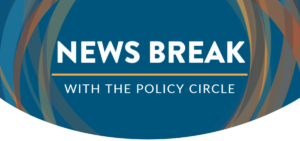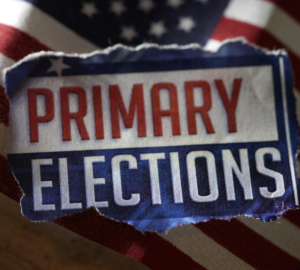
A look at top news stories with opportunities to learn more and take action.
If there’s additional news you think we should share, please email us at [email protected] to let us know.
ELECTIONS
The 2022 midterm primary season is well underway. This year, every eligible voter has an opportunity to make their voice heard by voting for federal, state, and local policy makers.
On the federal level, 34 seats in the 100-member U. S. Senate (members serve six-year terms) and all 435 seats in the U.S. House of Representatives (members serve two-year terms) are up for grabs this year. Currently, Democrats control both chambers of Congress, but Republicans only need to net one seat to retake the majority in the Senate, and five seats to retake the majority in the House.
Statewide primary elections to determine who makes it on the ballot in November will continue throughout the summer. In addition to local municipal elections, statewide general elections, like those for governor, attorney general, and secretary of state, will take place in every state this fall.
Voters in at least 35 states will vote on over 100 wide ranging ballot initiatives.
Take Your Civic Engagement To The Next Level: Using The Policy Circle’s Active Voter Guide and Ballotpedia’s sample ballot lookup tool, organize a discussion with first-time voters to help prepare them to exercise their civic duty.
SUPREME COURT
The nation’s high court will issue several important rulings in the coming weeks.
Primary among them is a case challenging Mississippi’s law banning most abortions after 15 weeks of pregnancy. An unprecedented leak of a draft opinion published by Politico in May indicated the court could be poised to overturn Roe v. Wade, the 1973 decision that ruled states cannot outlaw abortion prior to viability. On June 24, the court issued its ruling, finding that the U.S. Constitution does not confer a right to abortion or prohibit each state from regulating or prohibiting abortion, returning the authority to regulate abortion to the people and their elected representatives. With Roe overturned, access to abortion will depend on where someone lives.
Another closely watched ruling was the Supreme Court’s first major Second Amendment case in over a decade. On June 23, the court struck down a 1911 New York law requiring applicants for a concealed-weapons permit to demonstrate “proper cause” and “good moral character” to do so. The court ruled that the proper-cause requirement violates the Fourteenth Amendment by preventing law-abiding citizens with ordinary self-defense needs from exercising their Second Amendment right to keep and bear arms in public for self-defense.
Another headline grabbing case is about whether a public school district violated a football coach’s First Amendment rights. The district asked him to stop praying with students after games on the football field, and placed him on paid administrative leave after he refused to do so, leading him to sue alleging his right to free speech was violated.
Go Beyond The Headlines: Review and share The Policy Circle’s Judicial Branch Brief to better understand the third branch of the federal government. Read the recent Supreme Court rulings here.
ECONOMY

Americans have been grappling with rising prices since late last year and inflation is the number one problem on their minds as they head to the polls.
In May, consumer prices were 8.6% higher than they were a year ago — that’s the sharpest year-over-year spike since 1981. Surging food and energy costs are forcing many to make tough spending decisions. In May, food and energy prices rose more than 10% and 34% respectively compared to the same time last year. Earlier this month, the national average price for a gallon of gas surpassed $5 for the first time ever.
In an effort to tame inflation as recession fears loom, the nation’s central bank, the Federal Reserve, raised its benchmark interest rates three times this year. In its most aggressive move to date, the Fed raised interest rates by 0.75% — the largest increase since 1994. Higher interest rates make it more expensive to borrow money (ie: higher mortgage rates, credit card rates, auto loan rates, student loan rates). The Fed hopes higher interest rates will discourage spending, which will decrease demand and (eventually) lower inflation.
Despite rising inflation, the unemployment rate held steady for the third month in a row at 3.6% in May, slightly higher than the pre-pandemic 50-year low of 3.5% recorded in February 2020. Additionally, the number of Americans applying for unemployment benefits has been hovering near 50-year lows since March.
Convene for a Policy Circle Conversation: Gather your network to explore the key indicators used to track the economy using The Policy Circle’s Economic Growth Brief.
PUBLIC SAFETY

After reaching unprecedent levels over the last two years, the third most important issue on the minds of Americans is violent crime. Due to surges in major cities, and the crime increases often seen during the summer months, many law enforcement departments are ramping up their readiness efforts.
In 2020, violent crimes increased 5.6%. The 2020 homicide rate (6.5 per 100,000 residents) hit a 23-year-high, with homicides soaring nearly 30% compared to 2019. Federal data for 2021 is not available yet, but at least a dozen major U.S. cities broke their yearly homicide records last year.
This year, violent crimes are up in cities across America. Year to date, violent crime is up 30% in Chicago and nearly 40% in New York. Other cities have seen lesser, but still noteworthy increases, like Washington, DC (+11%) and Los Angeles (+9%).
Both federal and local policymakers are seeking to address widespread staffing shortages faced by police departments nationwide.
Dig Deeper: Dive into The Policy Circle’s Understanding Law Enforcement Brief to learn about those who work to ensure the safety of our communities.

